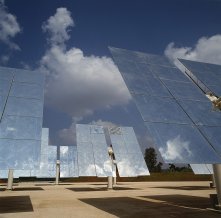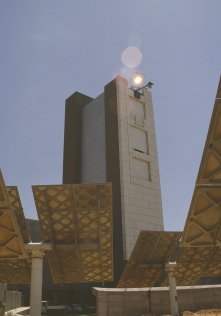
Innovative solar technology that may offer a "green" solution to the production of hydrogen fuel has been successfully tested on a large scale at the Weizmann Institute of Science in Israel. The technology also promises to facilitate the storage and transportation of hydrogen. The chemical process behind the technology was originally developed at Weizmann, and it has been scaled up in collaboration with European scientists. Results of the experiments will be reported in August at the 2005 Solar World Congress of the International Solar Energy Society (ISES) in Orlando, Florida.
The solar project is the result of collaboration between scientists from the Weizmann Institute of Science, the Swiss Federal Institute of Technology, Paul Scherrer Institute in Switzerland, Institut de Science et de Genie des Materiaux et Procedes—Centre National de la Recherche Scientifique in France, and the ScanArc Plasma Technologies AB in Sweden. The project is supported by the European Union's FP5 program.
Hydrogen, the most plentiful element in the universe, is an attractive candidate for becoming a pollution-free fuel of the future. However, nearly all hydrogen used today is produced by means of expensive processes that require combustion of polluting fossil fuels. Moreover, storing and transporting hydrogen is extremely difficult and costly.
The new solar technology tackles these problems by creating an easily storable intermediate energy source form from metal ore, such as zinc oxide. With the help of concentrated sunlight, the ore is heated to about 1,200°C in a solar reactor in the presence of wood charcoal. The process splits the ore, releasing oxygen and creating gaseous zinc, which is then condensed to a powder. Zinc powder can later be reacted with water, yielding hydrogen, to be used as fuel, and zinc oxide, which is recycled back to zinc in the solar plant. In recent experiments, the 300-kilowatt installation produced 45 kilograms of zinc powder from zinc oxide in one hour, exceeding projected goals.
The process generates no pollution, and the resultant zinc can be easily stored and transported, and converted to hydrogen on demand. In addition, the zinc can be used directly, for example, in zinc-air batteries, which serve as efficient converters of chemical to electrical energy. Thus, the method offers a way of storing solar energy in chemical form and releasing it as needed.

"After many years of basic research, we are pleased to see the scientific principles developed at the Institute validated by technological development," said Prof. Jacob Karni, Head of the Center for Energy Research at Weizmann.
"The success of our recent experiments brings the approach closer to industrial use," says engineer Michael Epstein, project leader at the Weizmann Institute.
The concept of splitting metal ores with the help of sunlight has been under development over the course of several years at the Weizmann Institute's Canadian Institute for the Energies and Applied Research, one of the most sophisticated solar research facilities in the world, which has a solar tower, a field of 64 mirrors, and unique beam-down optics. The process was tested originally on a scale of several kilowatts; it has been scaled up to 300 kilowatts in collaboration with the European researchers.
Weizmann scientists are currently investigating metal ores other than zinc oxide, as well as additional materials that may be used for efficient conversion of sunlight into storable energy.
The research from this press release was presented at the ISES 2005 Solar World Congress—Bringing Water to the World (http://www.swc2005.org/), which took place during August 6-12, 2005 in Orlando, FL, U.S. Prof. Jacob Karni's research is supported by the Sussman Family Center for the Study of Environmental Sciences; the Solomon R. and Rebecca D. Baker Foundation; the Angel Faivovich Foundation for Ecological Research; Mr. Nathan Minzly, UK; the Abraham and Sonia Rochlin Foundation; Mr. and Mrs. Larry Taylor, Los Angeles, CA; Dr. and Mrs. Robert Zaitlin, Los Angeles, CA; and the Arnold Ziff Charitable Foundation.The Weizmann Institute of Science in Rehovot, Israel, is one of the world's top-ranking multidisciplinary research institutions. Noted for its wide-ranging exploration of the natural and exact sciences, the Institute is home to 2,500 scientists, students, technicians, and supporting staff. Institute research efforts include the search for new ways of fighting disease and hunger, examining leading questions in mathematics and computer science, probing the physics of matter and the universe, creating novel materials, and developing new strategies for protecting the environment.
